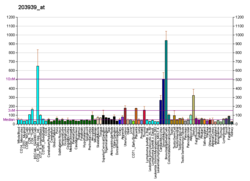NT5E
NT5E| NT5E | |||||||||||||||||||||||||
|---|---|---|---|---|---|---|---|---|---|---|---|---|---|---|---|---|---|---|---|---|---|---|---|---|---|
| |||||||||||||||||||||||||
| 식별자 | |||||||||||||||||||||||||
| 별칭 | NT5E, CALJA, CD73, E5NT, NT, NT5, NTE, eNT, eNT, 5'-뉴클레오티다아제 ecto | ||||||||||||||||||||||||
| 외부 ID | OMIM: 129190 MGI: 99782 HomoloGene: 1895 GeneCard: NT5E | ||||||||||||||||||||||||
| |||||||||||||||||||||||||
| |||||||||||||||||||||||||
| |||||||||||||||||||||||||
| |||||||||||||||||||||||||
| 직교체 | |||||||||||||||||||||||||
| 종 | 인간 | 마우스 | |||||||||||||||||||||||
| 엔트레스 | |||||||||||||||||||||||||
| 앙상블 | |||||||||||||||||||||||||
| 유니프로트 | |||||||||||||||||||||||||
| RefSeq(mRNA) | |||||||||||||||||||||||||
| RefSeq(단백질) | |||||||||||||||||||||||||
| 위치(UCSC) | Chr 6: 85.45 – 85.5Mb | Chr 9: 88.21 – 88.25Mb | |||||||||||||||||||||||
| PubMed 검색 | [3] | [4] | |||||||||||||||||||||||
| 위키다타 | |||||||||||||||||||||||||
| |||||||||||||||||||||||||
ecto-5--뉴클레오티다아제 또는 CD73(분화 73 클러스터)으로도 알려진 5n-뉴클레오티다아제(5nt-NT)는 인간에서 NT5E 유전자에 의해 암호화된 효소다.[5]CD73은 일반적으로 AMP를 아데노신(adenosine)으로 변환하는 역할을 한다.[6]
전사 계수 바인딩 사이트
NT5E는 c-AMP 프로모터 부품에서 찾을 수 있는 AP-2, SMAD 단백질, SP-1 및 c-AMP 에 대응하는 요소들을 위한 결합 사이트를 포함하고 있다.SMAD 2, 3, 4, 5와 SP-1은 염색질 면역소모 측정에서 입증된 바와 같이 랫드에서 NT5E 촉진자에 결합되어 있다.인간과 쥐 NT5E의 대화 내용이 89% 동일하다는 사실 때문에 인간 NT5E도 SMAD 단백질에 의해 조절될 수 있었다.[7]
함수
Ecto-5-prime-nucleotidase(5-premium-revonucleotide phosphohydolase; EC 3.1.3.5)는 퓨린 5-premiumucleotide의 중성 pH에서 변환을 촉진하며, 선호 기질은 AMP이다.효소는 혈장 막의 외부 표면에 글리코실 인산염 이노시톨 연계에 의해 결합된 2개의 동일한 70-kD 서브유닛의 디머로 구성된다.이 효소는 림프구 분화의 표지로 사용된다.결과적으로 NT5의 결핍은 다양한 면역결핍 질환에서 발생한다(예: MIM 102700, MIM 300300 참조).다른 형태의 5-프라임 뉴클레오티다아제는 세포질 및 라이소솜에 존재하며, 기질 친화성, 이온의 요구조건, ATP에 의한 활성화, 무기인산염에 의한 억제 등에 의해 ecto-NT5와 구별할 수 있다.[8]희귀한 알레르기의 변형은 관절과 동맥(CALJA)의 성인-온셋 석회화 증후군이 장골, 대퇴골, 경골동맥에 영향을 미쳐 다리와 손발의 관절의 순환을 감소시켜 통증을 유발하는 것과 관련이 있다.[9][10][11]
면역억제
NT5E(CD73)는 여러 세포에 발현되는 표면 효소다.이 효소는 ATP와 ADP의 자분비 및 파라크린 위험 신호를 항염증 아데노신(Adenosine)에 점진적으로 가수분해하는 작용을 한다.adenosinergic 경로에 의해 매개되는 면역 억제는 면역 시스템 동점선을 유지하는데 매우 중요하다.T 규제 세포의 면역 억제 기능도 CD73 표현에 의존한다.트레그는 일반적으로 면역 반응을 억제한다.그것들은 T세포의 확산과 기능에 영향을 미친다.[12]CD73은 무저항성 CD4 + T세포에서도 발생하므로 건강한 조직에 대한 자기 내성을 유지할 뿐만 아니라 임신 중 태아를 엄마의 면역체계로부터 보호할 수 있다.또한 아데노신 수용체를 표현하는 중성미자의 음성 피드백에 의해 염증성 면역 반응을 제한하는 NT5E에 의해 생성된 아데노신이 설명되었다.[13]
마약 타겟으로
일부 종양은 CD73의 상향조절과 과다압박을 가지고 있어 암치료의 약물목표로 제안되어 왔다.[14][15][16]
항CD73 항체 CPI-006이 고도암 치료제로 초기 임상실험을 시작했다.[17]
전신 루푸스 에리테마토스
미엘로이드 유래 억제 세포와 규제 T 세포와 같은 전문 면역 세포도 국소 ectonucleotidase에 의해 생성되는 아데노신을 통해 그 효과를 중재한다.루푸스 환자의 경우 CD73의 적절한 T세포 표현이 누락되어 T세포의 조절기능이 저하된 것을 알 수 있다.[18]
암
NT5E는 면역억제제 분자 역할을 할 수 있다.NT5E에 의해 생성된 무료 아데노신은 세포 면역 반응을 억제하여 종양 세포의 면역 탈출을 촉진한다.[13]CD73은 효소성 및 비효소성 성질로 인해 암 관련 과정에 관여하며 백혈병, 교모세포종, 흑색종, 난소성, 유방암 등 많은 암에서 조절된다.암 조절과 발육에 중요한 핵심 분자로 종양 진행에 관여한다.또한 NT5E는 접착 및 신호 분자의 기능을 하며 피브로넥틴, 라미네인 등 세포외 매트릭스 성분으로 세포신호를 조절할 수 있다.이것은 암의 전이성과 침습성을 중재할 수 있다.[19]쥐 유방 및 전립선암 종양 모델뿐 아니라 유방암 유전형성 모델에서도 NT5E가 종양 혈관신생을 지원하는 것으로 확인됐다.그의 표현은 황색세포와 인간 흑색종 세포와 인간의 유방암 세포의 침입과 전이를 촉진한다.몰로이드 유도 억제 세포(MDSC), 트레그, 덴드리트 세포(DC) 등 NT5E를 표현하는 세포에 의한 종양 침투는 아데노신의 축적을 이끈다.이후 아데노신 A2A 수용체를 표현하는 T세포에서 cAMP신호가 발동된다.[20]아데노신 수용체는 대식세포, DC, MDSC, 자연 킬러세포(NK)에서도 발현된다.따라서 아데노신은 이러한 면역세포의 기능을 억제할 수도 있다.또한 종양세포는 Gαi 단백질과 연관된 아데노신 A1 수용체와 A3 수용체를 표현하여 종양세포의 이동과 증식을 촉진할 수도 있다.[13][19][21]특히 생쥐 종양 모델에서 유익한 효과 때문에, CD73 치료는 이제 미래에 암 치료에 대한 유망한 접근법이 되었다.CD73 억제제는 현재 암 치료를 위한 임상시험에서 시험 중이다.[19]
miRNA
마이크로RNA는 mRNA와의 결합을 통해 유전자 발현을 변환 후 수준으로 조절하는 작은 비코딩 RNA 분자다.이는 대상 mRNA 분자의 저하 또는 변환적 억제로 이어진다.종양 세포에서 miRNA 발현 패턴은 자주 변화하며 따라서 표면 NT5E에 영향을 미치며 이로 인해 항투석 면역 반응이 방해된다.[22][23]예를 들어, 연구는 NT5E 규제에서 miR30 계열의 역할을 검증한다.miR-30a-5p 식에서는 NT5E 식이 감소했다.[13]
참고 항목
참조
- ^ a b c GRCh38: 앙상블 릴리스 89: ENSG00000135318 - 앙상블, 2017년 5월
- ^ a b c GRCm38: 앙상블 릴리스 89: ENSMUSG000032420 - 앙상블, 2017년 5월
- ^ "Human PubMed Reference:". National Center for Biotechnology Information, U.S. National Library of Medicine.
- ^ "Mouse PubMed Reference:". National Center for Biotechnology Information, U.S. National Library of Medicine.
- ^ Misumi Y, Ogata S, Ohkubo K, Hirose S, Ikehara Y (August 1990). "Primary structure of human placental 5'-nucleotidase and identification of the glycolipid anchor in the mature form". European Journal of Biochemistry. 191 (3): 563–9. doi:10.1111/j.1432-1033.1990.tb19158.x. PMID 2129526.
- ^ Allard, Bertrand; Cousineau, Isabelle; Spring, Kathleen; Stagg, John (2019-01-01), Galluzzi, Lorenzo; Rudqvist, Nils-Petter (eds.), "Chapter Fifteen - Measurement of CD73 enzymatic activity using luminescence-based and colorimetric assays", Methods in Enzymology, Tumor Immunology and Immunotherapy – Molecular Methods, Academic Press, 629: 269–289, doi:10.1016/bs.mie.2019.10.007, PMID 31727245, retrieved 2020-11-28
- ^ Kordaß T, Osen W, Eichmüller SB (2018). "Controlling the Immune Suppressor: Transcription Factors and MicroRNAs Regulating CD73/NT5E". Frontiers in Immunology. 9: 813. doi:10.3389/fimmu.2018.00813. PMC 5915482. PMID 29720980.
- ^ "Entrez Gene: NT5E 5′-nucleotidase, ecto (CD73)".
- ^ St Hilaire C, Ziegler SG, Markello TC, Brusco A, Groden C, Gill F, et al. (February 2011). "NT5E mutations and arterial calcifications". The New England Journal of Medicine. 364 (5): 432–42. doi:10.1056/NEJMoa0912923. PMC 3049958. PMID 21288095.
- ^ Sharp J (March 1954). "Heredo-familial vascular and articular calcification". Annals of the Rheumatic Diseases. 13 (1): 15–27. doi:10.1136/ard.13.1.15. PMC 1030367. PMID 13149051.
- ^ 온라인 멘델리안 상속인(OMIM): 211800
- ^ Dong K, Gao ZW, Zhang HZ (December 2016). "The role of adenosinergic pathway in human autoimmune diseases". Immunologic Research. 64 (5–6): 1133–1141. doi:10.1007/s12026-016-8870-2. PMC 5126201. PMID 27665459.
- ^ a b c d Kordaß T, Osen W, Eichmüller SB (2018-04-18). "Controlling the Immune Suppressor: Transcription Factors and MicroRNAs Regulating CD73/NT5E". Frontiers in Immunology. 9: 813. doi:10.3389/fimmu.2018.00813. PMC 5915482. PMID 29720980.
- ^ 2018년 암면역치료 아데노신 타겟팅
- ^ 항암면역치료의 CD73: 2016년 새로운 기회 깨우기
- ^ Ghalamfarsa G, Kazemi MH, Raoofi Mohseni S, Masjedi A, Hojjat-Farsangi M, Azizi G, Yousefi M, Jadidi-Niaragh F (2019). "CD73 as a potential opportunity for cancer immunotherapy". Expert Opin Ther Targets. 23 (2): 127–142. doi:10.1080/14728222.2019.1559829. PMID 30556751. S2CID 58767911.
- ^ 항CD73 항체제는 안전한 것으로 보이며, 고도암에 걸릴 가능성이 있음
- ^ Knight JS, Mazza LF, Yalavarthi S, Sule G, Ali RA, Hodgin JB, et al. (2018). "Ectonucleotidase-Mediated Suppression of Lupus Autoimmunity and Vascular Dysfunction". Frontiers in Immunology. 9: 1322. doi:10.3389/fimmu.2018.01322. PMC 6004379. PMID 29942314.
- ^ a b c Zhu J, Zeng Y, Li W, Qin H, Lei Z, Shen D, et al. (February 2017). "CD73/NT5E is a target of miR-30a-5p and plays an important role in the pathogenesis of non-small cell lung cancer". Molecular Cancer. 16 (1): 34. doi:10.1186/s12943-017-0591-1. PMC 5291990. PMID 28158983.
- ^ Yu M, Guo G, Huang L, Deng L, Chang CS, Achyut BR, et al. (January 2020). "2B-mediated feedforward circuit enforces an immune checkpoint". Nature Communications. 11 (1): 515. doi:10.1038/s41467-019-14060-x. PMC 6981126. PMID 31980601.
- ^ Tripathi, Abhishek; Lin, Edwin; Nussenzveig, Roberto; Yandell, Mark; Pal, Sumanta K.; Agarwal, Neeraj (2019-05-20). "NT5E expression and the immune landscape of prostate cancer (PC): An analysis from The Cancer Genome Atlas database". Journal of Clinical Oncology. 37 (15_suppl): e16591. doi:10.1200/JCO.2019.37.15_suppl.e16591. ISSN 0732-183X.
- ^ Bazhin AV, Amedei A, Karakhanova S (2018). "Editorial: Immune Checkpoint Molecules and Cancer Immunotherapy". Frontiers in Immunology. 9: 2878. doi:10.3389/fimmu.2018.02878. PMC 6290335. PMID 30568661.
- ^ Zhang F, Luo Y, Shao Z, Xu L, Liu X, Niu Y, et al. (April 2016). "MicroRNA-187, a downstream effector of TGFβ pathway, suppresses Smad-mediated epithelial-mesenchymal transition in colorectal cancer". Cancer Letters. 373 (2): 203–13. doi:10.1016/j.canlet.2016.01.037. PMID 26820227.
추가 읽기
- Resta R, Thompson LF (February 1997). "T cell signalling through CD73". Cellular Signalling. 9 (2): 131–9. doi:10.1016/S0898-6568(96)00132-5. PMID 9113412.
- Kirchhoff C, Hale G (March 1996). "Cell-to-cell transfer of glycosylphosphatidylinositol-anchored membrane proteins during sperm maturation". Molecular Human Reproduction. 2 (3): 177–84. doi:10.1093/molehr/2.3.177. PMID 9238677.
- Resta R, Yamashita Y, Thompson LF (February 1998). "Ecto-enzyme and signaling functions of lymphocyte CD73". Immunological Reviews. 161: 95–109. doi:10.1111/j.1600-065X.1998.tb01574.x. PMID 9553767. S2CID 29930691.
- Rosi F, Carlucci F, Marinello E, Tabucchi A (March 2002). "Ecto-5'-nucleotidase in B-cell chronic lymphocytic leukemia". Biomedicine & Pharmacotherapy. 56 (2): 100–4. doi:10.1016/S0753-3322(01)00072-5. PMID 12000134.
- Babiychuk EB, Draeger A (June 2006). "Regulation of ecto-5'-nucleotidase activity via Ca2+-dependent, annexin 2-mediated membrane rearrangement?". Biochemical Society Transactions. 34 (Pt 3): 374–6. doi:10.1042/BST0340374. PMID 16709165. S2CID 8728207.
- Stefanovic V, Mandel P, Rosenberg A (July 1976). "Ecto-5'-nucleotidase of intact cultured C6 rat glioma cells". The Journal of Biological Chemistry. 251 (13): 3900–5. doi:10.1016/S0021-9258(17)33333-1. PMID 819433.
- Thomson LF, Ruedi JM, Glass A, Moldenhauer G, Moller P, Low MG, et al. (January 1990). "Production and characterization of monoclonal antibodies to the glycosyl phosphatidylinositol-anchored lymphocyte differentiation antigen ecto-5'-nucleotidase (CD73)". Tissue Antigens. 35 (1): 9–19. doi:10.1111/j.1399-0039.1990.tb01750.x. PMID 2137649.
- Klemens MR, Sherman WR, Holmberg NJ, Ruedi JM, Low MG, Thompson LF (November 1990). "Characterization of soluble vs membrane-bound human placental 5'-nucleotidase". Biochemical and Biophysical Research Communications. 172 (3): 1371–7. doi:10.1016/0006-291X(90)91601-N. PMID 2173922.
- Boyle JM, Hey Y, Guerts van Kessel A, Fox M (December 1988). "Assignment of ecto-5'-nucleotidase to human chromosome 6". Human Genetics. 81 (1): 88–92. doi:10.1007/BF00283737. PMID 2848759. S2CID 22488106.
- Vlahović P, Stefanović V (1995). "Effect of dopamine on ecto-5'-nucleotidase expression in human glomerular mesangial cells". Archives Internationales de Physiologie, de Biochimie et de Biophysique. 102 (3): 171–3. doi:10.3109/13813459409007533. PMID 8000038.
- Hansen KR, Resta R, Webb CF, Thompson LF (December 1995). "Isolation and characterization of the promoter of the human 5'-nucleotidase (CD73)-encoding gene". Gene. 167 (1–2): 307–12. doi:10.1016/0378-1119(95)00574-9. PMID 8566797.
- Airas L, Jalkanen S (September 1996). "CD73 mediates adhesion of B cells to follicular dendritic cells". Blood. 88 (5): 1755–64. doi:10.1182/blood.V88.5.1755.1755. PMID 8781432.
- Airas L, Niemelä J, Salmi M, Puurunen T, Smith DJ, Jalkanen S (January 1997). "Differential regulation and function of CD73, a glycosyl-phosphatidylinositol-linked 70-kD adhesion molecule, on lymphocytes and endothelial cells". The Journal of Cell Biology. 136 (2): 421–31. doi:10.1083/jcb.136.2.421. PMC 2134816. PMID 9015312.
- Strohmeier GR, Lencer WI, Patapoff TW, Thompson LF, Carlson SL, Moe SJ, et al. (June 1997). "Surface expression, polarization, and functional significance of CD73 in human intestinal epithelia". The Journal of Clinical Investigation. 99 (11): 2588–601. doi:10.1172/JCI119447. PMC 508104. PMID 9169488.
- Aumüller G, Renneberg H, Schiemann PJ, Wilhelm B, Seitz J, Konrad L, Wennemuth G (1998). "The role of apocrine released proteins in the post-testicular regulation of human sperm function". The Fate of the Male Germ Cell. Advances in Experimental Medicine and Biology. Vol. 424. pp. 193–219. doi:10.1007/978-1-4615-5913-9_39. ISBN 978-1-4613-7711-5. PMID 9361795.
- Rosi F, Agostinho AB, Carlucci F, Zanoni L, Porcelli B, Marinello E, et al. (1998). "Behaviour of human lymphocytic isoenzymes of 5'-nucleotidase". Life Sciences. 62 (25): 2257–66. doi:10.1016/S0024-3205(98)00206-9. PMID 9651114.
외부 링크
- NT5E+단백질,+인간(MeSH) 미국 국립 의학 도서관의 의학 과목 제목
- PDBe-KB에서 UniProt: P21589(5′-뉴클레오티아제)에 대한 PDB의 모든 구조 정보 개요.
이 기사는 공공영역에 있는 미국 국립 의학 도서관의 텍스트를 통합하고 있다.







